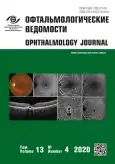Differential diagnosis algorithms of сentral serous chorioretinopathy and adult-onset vitelliform dystrophies
- Authors: Matcko N.V.1,2, Gatsu M.V.1,2
-
Affiliations:
- S. Fyodorov Eye Microsurgery Federal State Institution, the Saint Petersburg Branch
- I.I. Mechnikov North-Western State Medical University
- Issue: Vol 13, No 4 (2020)
- Pages: 35-46
- Section: Original study articles
- Submitted: 11.02.2021
- Accepted: 16.02.2021
- Published: 15.12.2020
- URL: https://journals.eco-vector.com/ov/article/view/60596
- DOI: https://doi.org/10.17816/OV60596
- ID: 60596
Cite item
Abstract
Purpose. To optimize the differential diagnosis of chronic central serous chorioretinopathy (CSCR) and of adult-onset vitelliform dystrophies (VD). Research objectives. On the multimodal diagnosis basis, to investigate signs characteristic for VD and chronic CSCR using mathematic modeling, to elaborate algorithms of their differential diagnosis in settings of differently equipped clinics.
Materials and methods. 61 patient (90 eyes) with long-term neuroepithelial detachments (NEDs) were included in the study. In all patients, the disease history was collected, including the family history; all patients underwent a standard ophthalmologic examination: visual acuity testing including best corrected visual acuity (BCVA), biomicroophthalmoscopy, fundus photography, spectral domain optical coherence tomography (SD-OCT) and optical coherence tomography angiography (OCT-A), short-wavelength autofluorescence (SW-AF), fluorescein angiography (FA), indocyanine green angiography (ICGA). Patients were divided into two groups: with vitelliform dystrophies — 30 patients (30 eyes), and with CSCR — 31 patients (31 eyes). To estimate the probability of disease detection, binary logistic regression method was used.
Results. Diagnostic predictors found in both groups were scrutinized; mathematical models for estimating the probability of disease detection were obtained. Differential diagnostics algorithms have been developed taking into account the resulting formulas for calculating the probability of disease detection, including criteria of different examination combinations: SD-OCT (area under ROC curve 0.946); BAF (area under ROC curve 0.955), SD-OCT and SW-AF (area under ROC curve 0.980); SW-AF, FA and ICGA (area under ROC curve 0.989).
Conclusion. The obtained models make it possible to carry out differential diagnosis of vitelliform dystrophies and chronic CSCR in settings of differently equipped clinics.
Full Text
About the authors
Nataliia V. Matcko
S. Fyodorov Eye Microsurgery Federal State Institution, the Saint Petersburg Branch; I.I. Mechnikov North-Western State Medical University
Author for correspondence.
Email: matsko.natalia@mail.ru
ORCID iD: 0000-0001-8909-9999
SPIN-code: 9790-4066
Ophthalmologist, S. Fyodorov Eye Microsurgery Federal State Institution, Saint Petersburg Branch, PhD Student, I.I. Mechnikov North-Western State Medical University
Russian Federation, St. Petersburg; St. PetersburgMarina V. Gatsu
S. Fyodorov Eye Microsurgery Federal State Institution, the Saint Petersburg Branch; I.I. Mechnikov North-Western State Medical University
Email: m-gatsu@yandex.ru
Dr. Sci. (Med.), Deputy Director of Clinical Services, S. Fyodorov Eye Microsurgery Federal State Institution, the Saint Petersburg Branch, professor, I.I. Mechnikov North-Western State Medical University
Russian Federation, St. Petersburg; St. PetersburgReferences
- Мацко Н.В., Гацу М.В., Григорьева Н.Н. Вителлиформные изменения макулярной области, встречающиеся у взрослых пациентов // Офтальмологические ведомости. – 2019. – T. 12. – № 4. – С. 73–86. [Macko NV, Gacu MV, Grigor’eva NN. Vitelliform changes in the central retina occurring in adults. Opththalmology Journal. 2019;(4):73–86. (In Russ.)] https://doi.org/10.17816/OV18513
- Renner A, Tillack H, Kraus H, et al. Morphology and functional characreristics in adult vitelliform macular dystrophy. Retina. 2004;24(6):929–939. https://doi.org/10.1097/00006982-200412000-00014
- Meunier I, Manes G, Bocquet B, et al. Frequency and Clinical Pattern of Vitelliform Macular Dystrophy Caused by Mutations of Interphotoreceptor Matrix IMPG1 and IMPG2 Genes. Ophthalmology. 2014;121(12):2406–2414. https://doi.org/10.1016/j.ophtha.2014.06.028
- Barbazetto IA, Yannuzzi NA, Klais CM, et al. Pseudo-vitelliform macular detachment and cuticular drusen: exclusion of 6 candidate genes. Ophthalmic Genet. 2007;28(4):192–197. https://doi.org/10.1080/13816810701538596
- Jaouni T, Averbukh E, Burstyn-Cohen T, et al. Association of pattern dystrophy with an HTRA1 singlenucleotide polymorphism. Arch Ophthalmol. 2012;130(8):987–991. https://doi.org/10.1001/archophthalmol.2012.1483
- Wang M, Munch IC, Hasler PW, et al. Central serous chorioretinopathy. Acta Ophthalmol. 2008;86(2):126–145. https://doi.org/10.1111/j.1600-0420.2007.00889.x
- Дога А.В., Качалина Г.Ф., Клепинина О.Б. Центральная серозная хориоретинопатия: современные аспекты диагностики и лечения. – М.: Офтальмология; 2017. – C. 9. [Doga AV, Kachalina GF, Klepinina OB. Central’naja seroznaja horioretinopatija: sovremennye aspekty diagnostiki i lechenija. Moscow: Oftal’mologija; 2017. P. 9. (In Russ.)]
- Lee YS, Kim ES, Kim М, еt al. Atypical vitelliform macular dystrophy misdiagnosed as chronic central serous chorioretinopathy: case reports. BMC Ophthalmology. 2012;12:25. https://doi.org/10.1186/1471-2415-12-25
- Zatreanu L, Freund KB, Leong BCS, еt al. Serous macular detachment in best disease: A masquerade syndrome. Retina. 2020;40(8):1456–1470. https://doi.org/10.1097/IAE.0000000000002659
- Гацу М.В. Фотодинамическая терапия — метод выбора при лечении хронических форм центральной серозной хориоретинопатии // IV Всеросс. семинар-«круглый стол» «Макула-2010»: тезисы докладов. 21–23 мая 2010. – Ростов-на-Дону. – С. 427–429. [Gacu MV. Fotodinamicheskaja terapija – metod vybora pri lechenii hronicheskih form central’noj seroznoj horioretinopatii. IV Vseross. seminar-«kruglyi stol» «Makula-2010»: tezisy dokladov. 21–23 maya 2010. – Rostov-na-Donu, 2010. – P. 427–429. (In Russ.)]
- Балашевич Л.И., Гацу М.В., Искендерова Н.Г. Эффективность диодной субпороговой микроимпульсной лазеркоагуляции при лечении различных форм центральной серозной ретинопатии // IV Всеросс. семинар-«круглый стол» «Макула 2010»: тезисы докладов. 21–23 мая 2010. – Ростов-на-Дону. – С. 416–418. [Jeffektivnost’ diodnoj subporogovoj mikroimpul’snoj lazerkoaguljacii pri lechenii razlichnyh form central’noj seroznoj retinopatii // IV Vseross. seminar-«kruglyj stol» «Makula 2010»: tezisy dokladov. 21–23 maja 2010. – Rostov-na-Donu, 2010. – P. 416–418. (In Russ.)]
- Трухачева H.В. Медицинская статистика в медико-биологических исследованиях пакета Stasistica. – М.: ГЭОТАР-Медиа; 2013. – 379. с. [Truhacheva HV. Medicinskaja statistika v mediko-biologicheskih issledovanijah paketa Stasistica. Moscow: GJeOTAR-Media; 2013. 379. p. (In Russ.)]
- Гонта А. Характеристики изображения: контраст, динамический диапазон, резкость // Алгоритм безопасности. – 2006. – № 5. – С. 56–60. [Gonta A. Harakteristiki izobrazhenija: kontrast, dinamicheskij diapazon, rezkost’. Algoritm bezopasnosti. 2006;5:56–60. (In Russ.)]
- Ergun E. Photodynamic therapy with verteporfin in subfoveal choroidal neovascularization secondary to central serous chorioretinopathy. Arch Ophthalmol. 2004;122(1):37. https://doi.org/10.1001/archopht.122.1.37
- Гацу М.В. Эффективность фотодинамической терапии при хронических формах центральной серозной хориоретинопатии. Причины неудач // VI Всеросс. семинар- «круглый стол» «Макула-2014»: тезисы докладов. 16–18 мая 2014. – Ростов-на-Дону, 2014. – С. 139–155. [Gacu MV. Jeffektivnost’ fotodinamicheskoj terapii pri hronicheskih formah central’noj seroznoj horioretinopatii. Prichiny neudach // VI Vseross. seminar- «kruglyj stol» «Makula-2014»: tezisy dokladov. 16–18 maja 2014. Rostov-na-Donu, 2014. – P. 139–155. (In Russ.)]
Supplementary files














